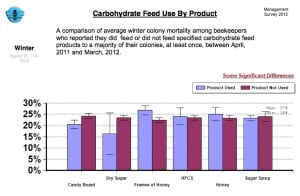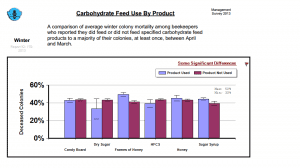Bottom Line at the Top
After reviewing the details of the BIP survey results for two years where feeding honeybees carbohydrates is concerned, some very surprising suggestions come to light. These results are statistically significant and come from sample sizes including thousands of beekeepers from all over the USA and tens of thousands of colonies. First, it doesn’t matter what carbohydrates you choose to feed your honeybees, you are either not improving their chances of survival or you are damaging their chances of survival. Those who do not feed are achieving as good or better survival rates.
There is one important exception. In every case, feeding honeybees frames of honey increases their chance of death. Talk about the unexpected! Let me repeat: if you feed your honeybees that which they would feed themselves, frames of honey, then you are increasing their chance of death. We don’t know the cause. But we have strong survey data speaking and we should listen.
Feeding Honeybees Honey May Increase Mortality
By Don Studinski, Colorado beekeeper and guest author for BIP
Many of us who practice “natural” beekeeping or “permaculture style” beekeeping are quite comfortable feeding our honeybees honey when they “must” be fed. We all know to never feed honey from the grocery store because it will likely contain American Foul Brood (AFB) spores. But when we feed back the honey, many times still in the frame, that we earlier harvested from this very colony, that seems harmless. Or when we feed a frame from another colony because we have a high degree of confidence the honey is disease free, we think to ourselves “what could be more natural, more healthy or more of exactly what a honeybee needs, than honey?” Notice that I’m using the inclusive pronouns, us, we and our. That’s because I spent many fine years using this philosophy.
Statistically, We Are Wrong
First, we will look at the Bee Informed Partnership survey results for 2011 – 20121. About 3600 beekeepers participated in the survey question representing about 233,000 colonies. That large sample size turned up exactly no difference where feeding carbohydrates is concerned. Feed your honeybees candy, dry sugar, high fructose corn syrup (HFCS), honey, sugar syrup, wet supers or nothing at all, it doesn’t matter, you get the same colony loss, in this case, about 23%.
Does that make you wonder why you are going to all that trouble to feed your bees? It should.
If lack of forage is a major contributor to honeybee decline, as some claim (read USDA), then why does it make no difference what so ever when beekeepers feed their bees? Well, “beekeepers must be feeding the wrong food” is one possible explanation. But what could be more “right” than honey? Let’s look further.
 Consider only those honeybees being fed. Only two methods of feeding showed statistically significant differences: candy boards and honey frames. Candy boards showed a positive effect and honey frames showed a negative effect. The survey covered all these feeding options: candy board, dry sugar, frames of honey, HFCS, honey and sugar syrup. Of all those feeding methods, the only one showing a positive effect was candy board. Those using candy boards lost fewer colonies than those not using candy boards, but only by about four of 100 colonies. And only one method showed a negative effect, honey frames. Those using honey frames lost more colonies than those not using honey frames, but again, only by about four colonies in 100.
Consider only those honeybees being fed. Only two methods of feeding showed statistically significant differences: candy boards and honey frames. Candy boards showed a positive effect and honey frames showed a negative effect. The survey covered all these feeding options: candy board, dry sugar, frames of honey, HFCS, honey and sugar syrup. Of all those feeding methods, the only one showing a positive effect was candy board. Those using candy boards lost fewer colonies than those not using candy boards, but only by about four of 100 colonies. And only one method showed a negative effect, honey frames. Those using honey frames lost more colonies than those not using honey frames, but again, only by about four colonies in 100.
Suppose this is an anomaly that showed up in the 2011 – 2012 survey, but will not be repeated. What does the next survey have to say about feeding honey?
The BIP survey results for 2012 – 2013 did show some differences2. But, I bet these are not the differences you expected. First, those who fed carbohydrates to their bees lost more colonies, significantly more, than those who did not feed. The survey covered the same six methods of feeding as before. This time, the participants increased to nearly 3800 representing slightly over 557,000 hives (nearly double the previous year hive count). Those who chose to feed their colonies lost about 45% while those that chose not to feed carbohydrates lost 36%.
Note that both 36% and 45% are more than the 23% shown in the 2011 – 2012 survey. Something seems to have affected the data overall from one year to the next.
 Again, in the 2012 – 2013 survey, two methods of feeding showed a statistically significant difference in colony mortality, but this time the two methods were sugar syrup and frames of honey. Both of these methods showed an increased mortality rate over those not using these feeding methods. Those who fed sugar syrup experienced about five more colony deaths per 100 colonies than those who did not feed sugar syrup. Those who fed frames of honey experienced about nine more colony deaths per 100 colonies.
Again, in the 2012 – 2013 survey, two methods of feeding showed a statistically significant difference in colony mortality, but this time the two methods were sugar syrup and frames of honey. Both of these methods showed an increased mortality rate over those not using these feeding methods. Those who fed sugar syrup experienced about five more colony deaths per 100 colonies than those who did not feed sugar syrup. Those who fed frames of honey experienced about nine more colony deaths per 100 colonies.
Needless to say, I found these results pretty counter intuitive. It’s a long way from what I would have instinctively assumed was true about honeybees and honey.
Conclusion
These results are very surprising. They are counter to my intuition. But until something strongly suggests otherwise, I must rethink my feeding practices. When I find honey left behind by a dead colony, I may harvest that honey for human consumption, but I will no longer pass that honey on to another colony. And when I find a struggling colony that I think I need to feed, then I might consider some candy, but I definitely will not be stealing honey frames from another colony to help them out.
Up to now, I thought I was helping my colonies when I provided supplemental carbohydrates. In fact, I have jars of syrup on several newly installed packages right now (5/12/2014). But these results will definitely change my practices where honey is concerned and may change my practices where syrup is concerned as well. Why would I want to go to all that extra work to end up hurting my colonies?
About the Author:
Don Studinski, dba Honeybee Keep, is a permaculture enthusiast and member of the board of directors at Living Systems Institute (LSI) where he applies permaculture philosophy to beekeeping. Apiaries under Don’s management are located from Golden to Erie, spanning about 50 miles. Honeybee Keep manages Colorado’s first Certified Naturally Grown apiaries. Don’s beekeeping articles have been published in Bee Culture magazine and on-line at Honeybee Haven, Peak Prosperity and Selene River Press.
As a beekeeping mentor, Don provides advice and counsel for students throughout the United States. You can reach him using dstudin@yahoo.com. Colorado Bees for Colorado Beekeepers is Don’s “produce local bees” project which will provide nucleus colonies for sale. Learn more about beekeeping, read free articles and see all the products and services provided by Honeybee Keep at HoneybeeKeep.com.
Don has a BS in Computer Science and an MS in Computer Information Systems. He spent his computer career working for IBM, StorageTek, and McKesson as a programmer, manager and director. He has also owned and operated his own t-shirt and embroidery business. Today, Don spends his time as a beekeeper, mentor and community building activist. He removes bees and wasps from structures, collects swarms, sells honey, performs public speaking, provides honey extraction and provides beekeeping consulting.
1 https://beeinformed.org/wp-content/uploads/2013/08/title-carbohydrate-feed.pdf visited 5/12/2014
2 https://beeinformed.org/wp-content/uploads/2014/03/6.-CarbohydrateFeedSummary.pdf visited 5/12/2014